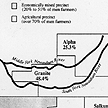 <---- Socialist vote by precinct, 1912 (click for full chart).
<---- Socialist vote by precinct, 1912 (click for full chart).
One key to the meteoric success of the Farmers' Alliance, and something today's progressive organizations should heed, was their conscious mix of diverse activities and goals. An Alliance picnic would include a talk on political economy; Alliance locals would meet to draft letters of support to urban workers on strike as well as to have social dances.
 |
 |
 |
 |
 |
Contents on this page were published in the July/August, 1996 edition of the Washington Free Press.
WFP, 1463 E. Republican #178, Seattle, WA -USA, 98112. -- WAfreepress@gmail.com
Copyright © 1996 WFP Collective, Inc.
